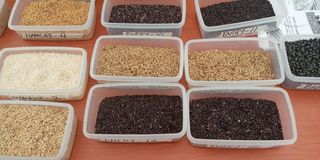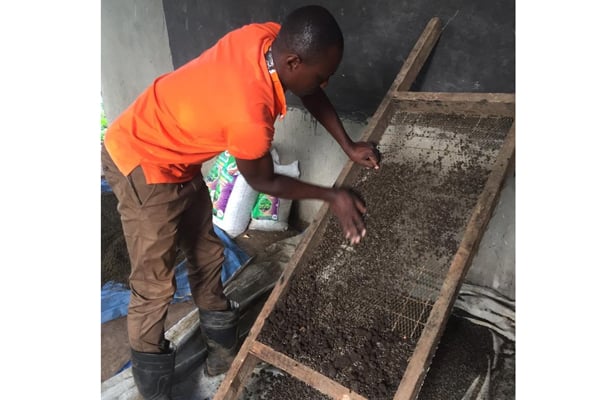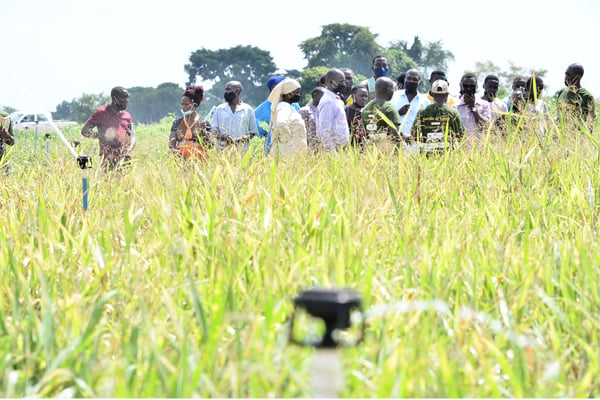Prime
Black rice: How to plant the new crop variety

Some samples of black rice on display. Photo/Lominda Afedraru
What you need to know:
- Black rice has a dark purplish-black colour with a nutty, slightly sweet flavour. Today black rice is picking up in popularity and popping up in more health food stores.
Agricultural scientists in Uganda have over the years been breeding rice both upland and low land irrigated rice with a number of verities released for farmer uptake.
Experts note that since the introduction of rice into Uganda in 1904, improvements of both upland and irrigated rain fed lowland rice varieties have been undertaken to address a number of production and quality constraints. These include increase in yield, pests and diseases, drought challenges as well as improvement to quality and tasty rice varieties.
However, this time scientists at the National Crops Resources Research Institute (NaCRRI) in cereal section have embarked on breeding black (purple) rice varieties to address the challenge of food nutrient because it contains Iron and Zinc components.
Background
Black rice is also called forbidden rice, which is a medium-grain, non-glutinous heirloom rice. Black rice has a dark purplish-black colour with a nutty, slightly sweet flavour. Today Black rice is picking up in popularity and popping up in more health food stores.
The demand for black rice has been increasing in today’s world because of their several biological activities due to the presence of antioxidants and phenolic compounds.
Dr Samson Ojok a rice breeder at NaCRRI explaining the purpose of breeding black rice notes that since it contains anti-oxidants it helps in fighting some diseases such as hypertension.
The scientists are also targeting children who are malnourished due to a number of factors.
Properties
The pericarp (outer covering) of black rice is black due to the presence of the black colour pigment called anthocyanin which is rich in antioxidants and poses a variety of health benefits such as anti-ageing, anticancer, anti-diabetes, lowering the risk of obesity. Black rice is glutinous and contains a high level of nutrients such as vitamin B, vitamin E, iron, thiamine, magnesium, niacin, phosphorous and it is also rich in dietary fiber.
Breeding process
Dr Ojok and his team of scientists started the breeding process three years ago through a collaborative research initiative under a programme Africa Rice with Ivory Coast. Since Uganda is a member of Africa Rice breeding programme, they acquired the breeding seed from West Africa and planted them at NaCRRI.
Newly released varieties
There are recently newly released varieties which include Naro Rice 1 containing straw coloured grains and matures in 95 days. The yield rate is 5,708 kilogrammes per hectare.
Naro Rice 2 matures in 120 days and has slender grains similar to Basmat rice variety imported from Pakistan with yield rate of 5,980 kilogrammes per hectare.
Naro Rice 3 matures in 115 days and it has heavy grains bigger than the preferred Super rice and it yields 4,760 kilogrammes per hectare.
Naro Rice 4 matures in 130 days and yields 6,520 kilogrammes per hectare with heavy and bigger grains. All these varieties are bred for purposes of substituting imported rice into the country and they are tolerant to Rice Mortal virus disease, Rice blight and bacterial leaf streak.
How to germinate black rice
It prefers warm climates and long growing seasons of at least three to six months. Black rice thrives under full sun and with generous watering. Successful germination requires sustained temperatures of at least 21°C.
Step one
Fill a container with room temperature water and soak the Black rice seeds for 24 hours. Then, use a sieve to remove any rice seeds that float, as they will not be viable for germination.
Step two
Strain off the water in the container and secure the lid on top to cover the seeds. Place the container in a sunny, warm location for 24 hours. Temperatures between 21 and 26°C are optimal.
Step three
Pull any weeds from your planting site and till the soil. Spread one inch of compost on top of the soil, using a rake to make the compost as level as possible.
Step four
Plant the Black rice seeds just under the surface of the compost, leaving approximately 9 inches between seeds.




